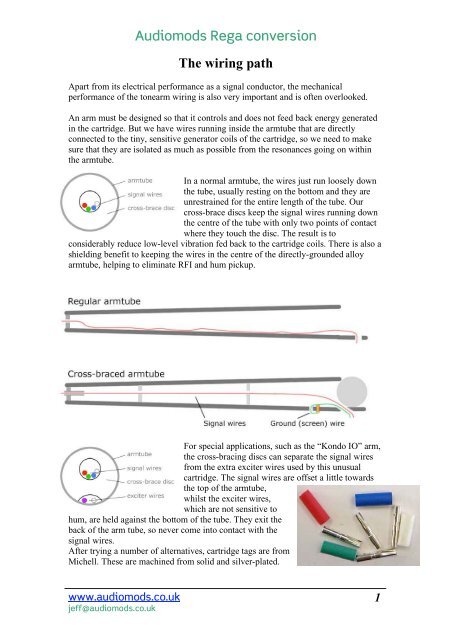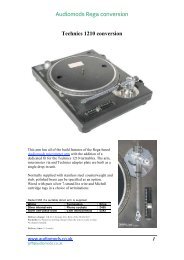Audiomods Rega conversion The wiring path
Audiomods Rega conversion The wiring path
Audiomods Rega conversion The wiring path
You also want an ePaper? Increase the reach of your titles
YUMPU automatically turns print PDFs into web optimized ePapers that Google loves.
<strong>Audiomods</strong> <strong>Rega</strong> <strong>conversion</strong><br />
<strong>The</strong> <strong>wiring</strong> <strong>path</strong><br />
Apart from its electrical performance as a signal conductor, the mechanical<br />
performance of the tonearm <strong>wiring</strong> is also very important and is often overlooked.<br />
An arm must be designed so that it controls and does not feed back energy generated<br />
in the cartridge. But we have wires running inside the armtube that are directly<br />
connected to the tiny, sensitive generator coils of the cartridge, so we need to make<br />
sure that they are isolated as much as possible from the resonances going on within<br />
the armtube.<br />
In a normal armtube, the wires just run loosely down<br />
the tube, usually resting on the bottom and they are<br />
unrestrained for the entire length of the tube. Our<br />
cross-brace discs keep the signal wires running down<br />
the centre of the tube with only two points of contact<br />
where they touch the disc. <strong>The</strong> result is to<br />
considerably reduce low-level vibration fed back to the cartridge coils. <strong>The</strong>re is also a<br />
shielding benefit to keeping the wires in the centre of the directly-grounded alloy<br />
armtube, helping to eliminate RFI and hum pickup.<br />
For special applications, such as the “Kondo IO” arm,<br />
the cross-bracing discs can separate the signal wires<br />
from the extra exciter wires used by this unusual<br />
cartridge. <strong>The</strong> signal wires are offset a little towards<br />
the top of the armtube,<br />
whilst the exciter wires,<br />
which are not sensitive to<br />
hum, are held against the bottom of the tube. <strong>The</strong>y exit the<br />
back of the arm tube, so never come into contact with the<br />
signal wires.<br />
After trying a number of alternatives, cartridge tags are from<br />
Michell. <strong>The</strong>se are machined from solid and silver-plated.<br />
www.audiomods.co.uk<br />
jeff@audiomods.co.uk<br />
1
<strong>Audiomods</strong> <strong>Rega</strong> <strong>conversion</strong><br />
Termination options<br />
Phono sockets<br />
<strong>The</strong> most popular option is to have the <strong>wiring</strong> terminated to a phono socket block<br />
which can be fixed to the turntable arm board/plinth or to a mounting plate held by<br />
the arm fixing nut.<br />
This has several advantages:<br />
- you can try different interconnects and decide your favourite. Without getting into<br />
the more exotic arguments about cable choice, it’s reasonable to say that different<br />
cartridge/phono amp combinations might prefer different capacitance/impedance<br />
characteristics.<br />
- features of the perfect tonearm wire like extreme flexibility don’t necessarily make<br />
the best interconnect. This is especially true with very fine cables where simple<br />
resistance might be a factor in interconnect-length application.<br />
- only the fine signal wires are connected to the arm, eliminating another source of<br />
vibration feedback.<br />
For a terminal block to work properly in a<br />
<strong>Rega</strong>-based installation, it should be able to<br />
pass through the 23mm armboard<br />
mounting hole.<br />
Our terminal block is made in two halves.<br />
<strong>The</strong> back (top of the picture), which carries<br />
the grounding wire, unscrews to allow the<br />
two parts to pass through the mounting<br />
hole. <strong>The</strong> block is then fixed to a<br />
convenient point on the plinth.<br />
Five-pin plug<br />
This is the standard “DIN”-type plug used by several<br />
manufacturers. We use one manufactured by Cardas.<br />
It is a very neat solution and one that completely<br />
protects the internal <strong>wiring</strong>, but it does mean that you<br />
need to use an appropriately terminated interconnect.<br />
This plug increases the height of the base column by<br />
approximately 15mm when the vta is in the fully<br />
lowered position.<br />
Either of these two terminations can use any of our<br />
<strong>wiring</strong> options, though we recommend the five-pin<br />
when Audio Note wire is chosen because of the<br />
delicate nature of the wire.<br />
www.audiomods.co.uk<br />
jeff@audiomods.co.uk<br />
2
<strong>Audiomods</strong> <strong>Rega</strong> <strong>conversion</strong><br />
Complete loom<br />
A one-piece run of silver-in-teflon wire from cartridge pins to pre-amp, using the<br />
Isokinetik <strong>wiring</strong> loom. This provides 1m of interconnect cable built in.<br />
Arms wired in this way will need about 20mm more clearance under the turntable<br />
than the standard <strong>Rega</strong> arm.<br />
www.audiomods.co.uk<br />
jeff@audiomods.co.uk<br />
3







